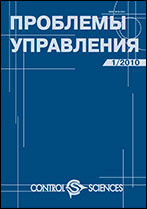|
This article is cited in 1 scientific paper (total in 1 paper)
Information technologies controls
Decentralized autonomic synchronization of interaction processes of mobile objects
G.G. Stetsyura
V.A. Trapeznikov Institute of Control Sciences of Russian Academy of Sciences, Moscow, Russia
Abstract:
A fully decentralized autonomous method of synchronization of objects interaction in distributed systems of mobile objects (for example, robots) is proposed. It synchronizes the simultaneous transmission of signals from a group of signal-source objects to a group of signal receivers, accelerates group data transmission and execution of distributed computations directly in the network facilities of the system. Decentralization eliminates the presence of a center that manages the synchronization processes within the group of objects. Autonomy allows performing synchronization without interaction with external controlling technical means. The objects of the group exchange non-directional signals via wireless optical or radio communication channels. Two interacting synchronization processes are used. The main purpose of the first process of the group sync process is to sequence the actions of a group of asynchronous objects and provide input data for the second sync correction process. The second process accelerates the group data transmission and the execution of distributed computations directly in the network facilities of the system due to faster and more accurate account for changes in the location of moving objects than in the first process. The first process can be used independently of the second process to determine the location, speed, and acceleration of moving objects relative to each other and to external active or passive objects. On the whole, the proposed synchronization without the influence of a dedicated control center translates a group of mobile objects from a random state into a synchronized mobile system.
Keywords:
mobile objects group, synchronization, autonomy, decentralization, system self-organization, synchronous distributed network computing.
Received: 29.05.2020
Revised: 28.07.2020
Accepted: 04.09.2020
Citation:
G.G. Stetsyura, “Decentralized autonomic synchronization of interaction processes of mobile objects”, Probl. Upr., 2020, no. 6, 46–56
Linking options:
https://www.mathnet.ru/eng/pu1218 https://www.mathnet.ru/eng/pu/v6/p46
|

| Statistics & downloads: |
| Abstract page: | 74 | | Full-text PDF : | 35 | | References: | 16 | | First page: | 1 |
|




 Contact us:
Contact us: Terms of Use
Terms of Use
 Registration to the website
Registration to the website Logotypes
Logotypes








 Citation in format
Citation in format 
